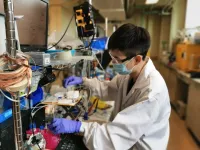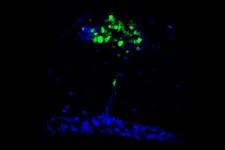(Press-News.org) Scientists have developed the first cells that can construct artificial polymers from building blocks that are not found in nature, by following instructions the researchers encoded in their genes.
The study, led by scientists from the Medical Research Council (MRC) Laboratory of Molecular Biology, in Cambridge, UK, also found the synthetic genome made the bacteria entirely resistant to infection by viruses.
The scientists say their research could lead to the development of new polymers - large molecules made of many repeating units, such as proteins, plastics, and many drugs including antibiotics - and make it easier to manufacture drugs reliably using bacteria.
The research, published today in the journal Science, builds on previous ground-breaking work by the team when, in 2019, they developed new techniques to create the biggest ever synthetic genome - constructing the entire genome of the bacterium Escherichia coli (E.coli) from scratch.
Using cells' natural protein-making processes
The scientists' goal was to utilise their new technology to create the first cell that can assemble polymers entirely from building blocks that are not found in nature.
Proteins are a type of polymer, so the scientists aimed to make artificial polymers by exploiting cells' natural protein-making processes.
The genetic code instructs a cell how to make proteins, which are constructed by joining together strings of natural building blocks, called amino acids.
The genetic code in DNA is made up of four bases, represented by the letters: A, T, C and G. The four letters in DNA are 'read' in groups of three letters - for example 'TCG' - which are called a 'codon'.
Each codon tells the cell to add a specific amino acid to the chain - it does this via molecules called 'tRNA'. Each codon has a specific tRNA that recognises it and adds the corresponding amino acid, for example: the tRNA that recognises the codon 'TCG', brings the amino acid serine.
With four letters in groups of three, there are 64 possible combinations of letters; however, there are only 20 different natural amino acids that cells commonly use. So, several different codons can be synonymous - they all code for the same amino acid - for example: TCG, TCA, AGC and AGT all code for serine.
There are also codons which tell a cell when to stop making a protein, such as TAG and TAA.
Re-writing the whole genome
When, in 2019, the team at the MRC Laboratory of Molecular Biology created the first entire genome synthesised from scratch for the commonly studied bacteria, E. coli, they also took the opportunity to simplify its genome.
They replaced some of the codons with their synonyms: they removed every instance of TCG and TCA and replaced them with the synonyms AGC and AGT.
They also removed every instance of the 'stop' codon TAG and replaced it with its synonym TAA.
The modified bacteria no longer had the codons TCG, TCA and TAG in their genome, but they could still make normal proteins and live and grow.
Resistant to viruses
Now, in their latest research, the scientists have further modified the bacteria to remove the tRNA molecules that recognise the codons TCG and TCA. This means that - even if there are TCG or TCA codons in the genetic code - the cell no longer has the molecule that can read those codons.
This is fatal for any virus that tries to infect the cell, because viruses replicate by injecting their genome into a cell and hijacking the cell's machinery. Virus genomes still contain lots of the TCG, TCA and TAG codons, but the modified bacteria are missing the tRNAs to read these codons.
When the machinery in the modified bacteria tries to read the virus genome, it fails every time it reaches a TCG, TCA or TAG codon.
In this study, the researchers infected their bacteria with a cocktail of viruses. Unmodified normal bacteria were killed by the viruses, but the modified bacteria were resistant to infection and survived.
Making bacteria resistant to viruses could make manufacturing certain types of drugs more reliable and cheaper. Many drugs - for example, protein drugs, such as insulin, and polysaccharide and protein subunit vaccines - are manufactured by growing bacteria which contain instructions to produce the drug.
Professor Jason Chin, from the MRC Laboratory of Molecular Biology, who led the study, said: "If a virus gets into the vats of bacteria used to manufacture certain drugs then it can destroy the whole batch. Our modified bacterial cells could overcome this problem by being completely resistant to viruses. Because viruses use the full genetic code, the modified bacteria won't be able to read the viral genes."
Living factories for synthetic polymers
By creating bacteria with synthetic genomes that do not use certain codons, the researchers had freed up those codons to be available to be used for other purposes, such as coding for synthetic building blocks, called monomers.
Professor Chin said: "This system allows us to write a gene that encodes the instructions to make polymers out of monomers that don't occur in nature.
"These bacteria may be turned into renewable and programmable factories that produce a wide range of new molecules with novel properties, which could have benefits for biotechnology and medicine, including making new drugs, such as new antibiotics."
"We'd like to use these bacteria to discover and build long synthetic polymers that fold up into structures and may form new classes of materials and medicines. We will also investigate applications of this technology to develop novel polymers, such as biodegradable plastics, which could contribute to a circular bioeconomy."
They engineered the bacteria to produce tRNAs coupled with artificial monomers, which recognised the newly available codons (TCG and TAG).
They inserted genetic sequences with strings of TCG and TAG codons into the bacteria's DNA. These were read by the altered tRNAs, which assembled chains of synthetic monomers in the sequence defined by the sequence of codons in the DNA.
The cells were programmed to string together monomers in different orders by changing the order of TCG and TAG codons in the genetic sequence.
Polymers composed of different monomers were also made by changing which monomers were coupled to the tRNAs.
The researchers were able to create polymers made of up to eight monomers strung together. They joined the ends of these polymers together to make macrocycles - a type of molecule that form the basis of some drugs, such as certain antibiotics and cancer drugs.
In this study, the synthetic monomers were linked together by the same chemical bonds that join together amino acids in proteins, but the researchers are investigating how to expand the range of linkages that can be used in the new polymers.
Dr Megan Dowie, head of molecular and cellular medicine at the Medical Research Council, which funded the study, said: "Dr Chin's pioneering work into genetic code expansion is a really exciting example of the value of the MRC's long-term commitment to discovery science. Research like this, in synthetic and engineering biology, has huge potential for major impact in biopharma and other industrial settings."
INFORMATION:
Hydrogels are polymer materials made mostly from water. They can be used in a wide range of medical and other applications. However, previous incarnations of the materials suffered from repeated mechanical stress and would easily become deformed. A novel crystal that can reversibly form and deform, allows hydrogels to rapidly recover from mechanical stress. This opens up the use of such biocompatible materials in the field of artificial joints and ligaments.
Many of us suffer the occasional sports injury or experience some kind of pain relating to joints and ligaments at some point in our lives. ...
Researchers from University of Toronto Engineering have developed an improved electrochemical system that raises the value of captured CO2 by converting more of it into valuable products than ever before.
The International Energy Agency recently cited carbon capture and storage as one of the strategies that can help keep global emissions low enough to limit global warming to 1.5 C by 2050. But captured carbon currently has little economic value, reducing the incentive for companies to invest in this technology.
A University of Toronto Engineering team led by Professor Ted Sargent is addressing this challenge by designing advanced electrolyzers that use electricity to convert captured CO2 into the petrochemical building blocks of common everyday materials, ...
An engineering researcher from the University of Sydney, in collaboration with a team at the University of Toronto, has developed an electrochemical system that coverts a greater amount of CO2 into valuable products.
The International Energy Agency recently cited carbon capture and storage as a strategy that can help keep global emissions low enough to limit global warming to 1.5°C by 2050. However, captured carbon currently has little economic value, reducing the incentive for companies to invest in this technology.
The team of researchers has addressed this challenge by designing advanced electrolysers - machines using electricity to convert captured CO2, plus water, into the building blocks of common everyday materials, ...
Astronomers have measured very-high-energy gamma rays coming from the aftermath of a gamma ray burst - an enormously energetic explosion of a star in another galaxy. The results shine light on these immensely powerful but little-understood cosmic events, and challenge standard models of how gamma ray bursts radiate light during their afterglow phases. As a dying massive star enters its final death throes, its core begins to collapse, and then explodes as a supernova. Some types of supernovae generate jets of particles moving at close to the speed of light; if the jet is pointed directly towards Earth it can be observed as a burst of gamma ray radiation that lasts several seconds. These gamma ray bursts are sometimes ...
The widespread non-pharmaceutical interventions implemented to mitigate the transmission of COVID-19 have led to drastic reductions in the annual circulation patterns of other endemic respiratory viruses, including influenza and the common cold. How this will affect future transmission patterns of these pathogens remains unknown. In a Perspective, Gabriela Gomez and colleagues discuss what could be expected concerning the epidemiology of common respiratory viruses once the COVID-19 pandemic subsides and argue that expanded genomic and clinical surveillance is needed to best understand the spread of respiratory viruses in a post-COVID-19 world. "Currently, the emergency response to COVID-19 is a global priority, but preparation for future threats ...
Nineteen million years ago, sharks nearly disappeared from Earth's oceans, according to a new study, which provides evidence for a previously unknown mass ocean extinction event. Sharks as a species never recovered from this, the study's authors say; their diversity today represents only a fraction of what it once was, the data suggest. Much of what is known about ancient ocean ecosystems is derived from rock and fossil records, which are generally limited to shallow-water deposits and provide only a small glimpse into the ocean-wide history of marine ...
By engineering the genetic code of a synthetic strain of E. coli to include several nonstandard amino acids, researchers rendered the synthetic bacterium virtually invincible to viral infection. Their work is some of the first to design proteins using not one but multiple non-canonical amino acids. "The ability to generate designer proteins using multiple non-natural building blocks will unlock countless applications, from the development of new classes of biotherapeutics to biomaterials with innovative properties," write Delila Jewel and Abhishek Chatterjee in a related Perspective. In nature, biological systems use 64 codons - a unique triplet of nucleotides - to encode ...
Small-scale mixed-use agriculture that avoids synthetic fertilizers in favor of manure could eliminate agricultural greenhouse gas emissions if established across the United States' 100 million hectares of lush high quality cropland, according to a study by Gidon Eshel, publishing 3rd June 2021 in the open-access journal PLOS Biology. The minor catch: beef consumption would need to decrease, but by only 20%.
Beef is the most resource-intensive food item that we regularly put into our shopping carts -- for every gram of protein, beef uses 7 times more cropland and 20 times as much water and emits 11 times the greenhouse gases. At the same time, cattle manure is a valuable source of natural fertilizer. Nitrogen-sparing agriculture avoids external inputs of nitrogen, such as synthetic ...
A collection of genetic variants influences the expression of obesity-associated genes in both the brain and fat tissue, according to a new study from researchers at the University of Chicago. The research team found that changes in the expression of the obesity-associated genes correlated with both metabolic and behavioral changes, suggesting that these variants produce combinatorial effects that increase the risk of obesity. The results, which scientists hope will lead to better understanding of the mechanisms that make some people more susceptible to obesity, were published June 4 in END ...
The immune system is the brain's best frenemy. It protects the brain from infection and helps injured tissues heal, but it also causes autoimmune diseases and creates inflammation that drives neurodegeneration.
Two new studies in mice suggest that the double-edged nature of the relationship between the immune system and the brain may come down to the origins of the immune cells that patrol the meninges, the tissues that surround the brain and spinal cord. In complementary studies published June 3 in the journal Science, two teams of researchers at Washington University School of Medicine in St. Louis unexpectedly found that many of the immune cells in the meninges come from bone marrow in the skull and migrate to the brain through special channels without passing through ...


